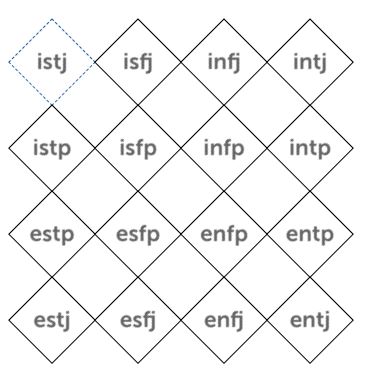The Myers-Briggs (MBTI®) personality assessment is widely used in the workplace to increase understanding, improve communication and build awareness of our unique differences. When these differences are overlooked, this can be the source of conflict and misunderstanding leading to poor performance.
Knowing our basic differences in how we are energized, gather information, make decisions and perceive our environment increases effectiveness as a leader and a team member.
We have used the MBTI for several decades and have found it widens perspective and deepens situational awareness as leaders increase their self-knowledge.
Your Personality Type is conveyed in a 4-letter code. The 16 personality types of the Myers-Briggs Type Indicator are listed here in what is called a “type table.”

MBTI Introduction
Critiques of the MBTI
Because this instrument has been around for over seventy years, there are some who believe it is outdated. This is an example of how the test of time serves the assessment well. It has been around, and with its widespread use, has demonstrated the 4 letter type is effective identifying normal differences in how we live and work. When these are over looked, conflict and misunderstanding can be the result.
The MBTI is recognizes we are all unique. It is a powerful instrument, helpful in identifying innate gifts, strengths and blind spots.
Personal development is a lot like investing – the more you put in – the more you get out of it.
The 4 Categories in the MBTI
The MBTI is broken into these 4 scales and your preference for one or the other is identified. Preferences tend to be hardwired. It is ideal to develop the non-dominant preference to be well rounded, however most of us will default to our preference when pressured.
Take a moment and write your name with your dominant hand. Now rewrite it with your non-dominant hand. Awkward? Yes, and with practice, it will feel more natural and you will get better producing the final script. It is like this with each of these pairs of preferences. Your type identifies your preference and offers up the opportunity to develop your non dominant preference.
I-E: Introversion – Extraversion
These terms are familiar to most people – but the meaning goes deeper than that in everyday use.
Extroverts are outgoing, enjoying social interaction; in the Myers Briggs, being extroverted means you are energized by this interaction. Extroverts can be called, “the life of the party,” and on the downside as dominant or pushy. That is a judgement and does not accurately describe that individual. Without the knowledge that we each have a preference of how we are energized, these judgments will distort your view of another.
Introverts have been called shy and withdrawn however that is not an accurate description. Introverts are energized by thinking and drained by too much social interaction. They are usually quieter and take in the social scene and or situation before they jump in. They can appear to be standoffish, but again, this is not accurate – they are simply taking time to reflect.
N-S: Intuitive (N) – Sensing
This dimension describes how people gather information from the world around them.
Those with a sensing preference tend to be oriented to the moment. They are tuned into what they can pick up with their 5 senses. They prefer facts and enjoy hands on experience.
Those who prefer intuition pay more attention are future oriented and notice patterns and possibilities. They are big picture thinkers and conceptual.
Can you see how someone who has the sensing function would be frustrated by someone who has the preference for intuitive function? And vice versa. Knowing there are these natural differences will you both understand these differences and not take it personal that you are asking questions or refuting each other’s perception.
T-F: Thinking – Feeling
This scale describes how you make decisions based on the information you have gathered.
People who have a thinking preference use a logical, factual approach to decision making. This approach comes off as being impersonal.
Those with a preference for the feeling function make value decisions based on consensus or the impact the decision has on others.
Both are rational approaches to making decision, however one uses facts and the other people when deciding.
J-P: Judging – Perceiving
This scale describes how people interact with their world.
Those with a Judging function tend to like structure. They like agenda’s and a written plan.
Those with a Perceiving function are more flexible and like to be spontaneous.
If you enjoyed this post, please share it by pinning it!







Responses